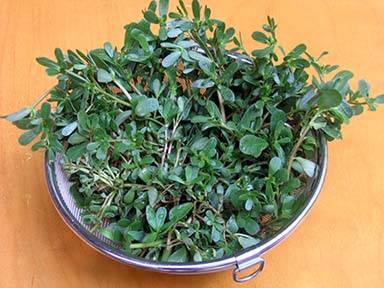 Nearly everyone knows that a salad of spinach is nutritionally superior to one of iceberg lettuce. But what if there was something that made spinach look like a lightweight?
Nearly everyone knows that a salad of spinach is nutritionally superior to one of iceberg lettuce. But what if there was something that made spinach look like a lightweight?
What if it grew nearly effortlessly, with each plant capable of producing over 52,000 seeds? What if the seeds of its 500 species could remain dormant for up to 30 years, withstanding droughts and other unfavorable conditions? And what if there were no less than nine genera native to North America? Of course, you’d want to grow it. Heck, you would devote an entire bed to it and wonder why others weren’t doing the same. But as the plants emerged you would realize you’ve seen them before. In fact you’ve probably spent hours removing them from your garden, your sidewalk, the cracks in your driveway… because they are purslane.
Purslane is one of those plants that makes you wonder about why we eat what we do and why the national diet is so far off the rails. Ounce for ounce it has more beta-carotene than spinach, as well as high levels of magnesium and potassium. Purslane even contains alpha linolenic acid, a type of omega-3 fatty acid. And, each 3.5 ounce serving contains only 15 calories per 3.5 ounce serving.
Purslane is actually an ancient food, part of the cuisines of Greece and Central America. Russians also use it, drying and canning it for winter. In Mexico, it is called verdolaga and is a favorite comfort food. There, it is eaten in omelets, as a side dish, rolled in tortillas, or dropped by handfuls into soups and stews. Its slightly lemony flavor goes especially well with pork.
In recent years, purslane found its way to the kitchens of Michelin chefs, including New York’s acclaimed Daniel Boulud of Daniel. Locally, if it’s not in your yard, you can find it at Ed Harper’s booth at the Champaign Farmers market.
Purslane is best if used fresh. If you must store it, wrap it in a moist paper towel and store in a plastic bag in the vegetable bin of your refrigerator. To use it, wash it to remove any dirt. Remove larger stems. Some recipes use only the leaves.
Purslane can be substituted for spinach or wild greens in lasagnas, filled pastas, and Greek-style tarts. Here are some other great ways to use it:
Anatolian Purslane, Lamb and Lentil Stew
Cucumber Purslane Yogurt Salad
Mexican Purslane Stuffing
Creamy Purslane Potato Salad
Oil & Vinegar Purslane Potato Salad
Spicy Purslane Potato Salad
Food & Wine’s Purslane Potato Salad
Mexican Pork & Purslane
Karen Hursh Graber’s Mexican Pork and Purslane is amazing, but the tomatillos her recipe calls for are often available only in the later part of the season in this latitude. So, I punt with this:
Pork and Purslane Stew
- 2 lbs pork kabob meat cut into 1-inch chunks
- Salt, pepper to taste
- 1 ½ pounds green tomatoes coarsely chopped
- 1 jalapeno, seeded and deribbed
- 2 cloves garlic, thinly sliced
- 1 medium onion, diced
- 2 c or more purslane cleaned and stemmed
Heat a large nonreactive Dutch oven over a moderate flame. Pour in enough oil to coat bottom. Season pork with salt and pepper. Brown pork in oil in batches if necessary. Remove meat and set aside. Add tomatoes, using their liquid to remove any browned bits from the bottom of the pan. When bottom of pan is clear, pour tomatoes over meat. Wipe out pan. Reheat pan. Add 1 to 2 T of additional oil. Add garlic, jalapeno, and onions. Saute until fragrant and onions are translucent. Add tomatoes and meat and simmer with lid on until pork is tender. Add purslane, and simmer 10 minutes more. Serve with rice.








